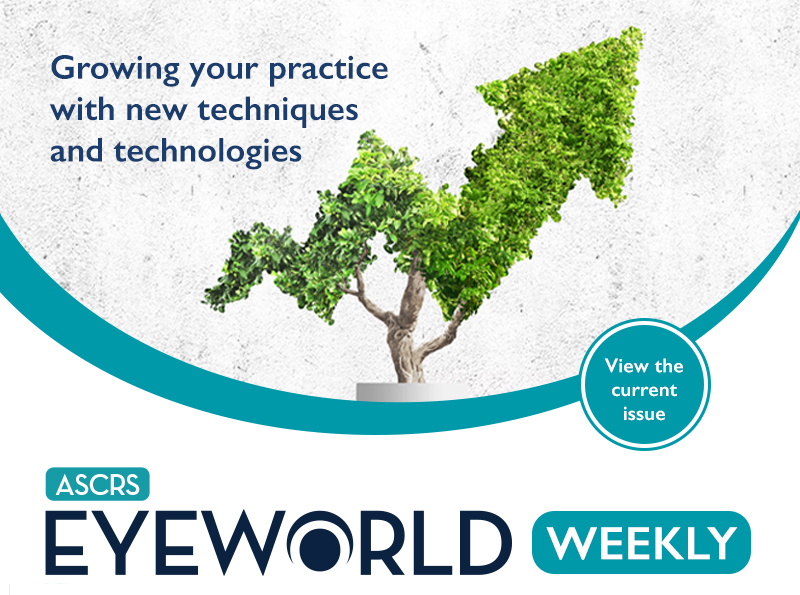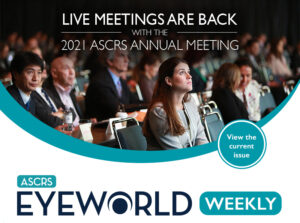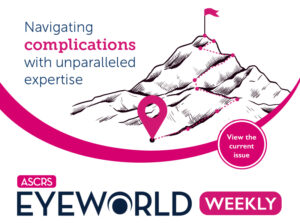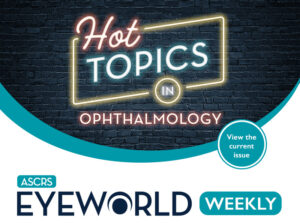
- Machine assesses cardiovascular risk with retinal scan
- FDA requests more info for BLA for bevacizumab
- Genetic variables affect NMOSD treatment
- Study: 12-month results from canaloplasty-trabeculotomy procedure
- Topline results from Phase 3 pivotal trial evaluating pupil-modulating drug
- ASCRS news and events
June 3, 2022 • Volume 28, Number 22
Machine assesses cardiovascular risk with retinal scan
A retinal imaging and artificial intelligence platform is coming to the U.S. with the ability to assess cardiovascular risk through retina scans. ORAiCLE, a platform created by Toku Eyes, is designed to identify small changes in blood vessels, capillaries, arteries, pigmentation, and calcification. According to the company’s press release, these factors are analyzed with a proprietary, patent-pending technology to stratify a person’s risk of having an adverse cardiovascular event within the next 5 years to inform possible preventative care. The company stated that this technology has already been used in New Zealand and India and, through partnership with Unified Imaging, is expanding into the U.S. The company said that it is also developing another product (THEIA, not yet available in the U.S.) that identifies vision-threating conditions in retinal images.
FDA requests more info for BLA for bevacizumab
Outlook Therapeutics, which is developing an ophthalmic formulation of bevacizumab for retinal indications, announced that the FDA requested more information for its Biologics License Application (BLA) of ONS-5010/LYTENAVA (bevacizumab) for wet AMD. According to the company’s press release, Outlook Therapeutics voluntarily withdrew its BLA, originally submitted in March, and is working to respond to the FDA’s request with a plan to resubmit by September 2022.
Genetic variables affect NMOSD treatment
Horizon Therapeutics announced data from its Phase 3 pivotal trial of UPLIZNA (inebilizumab-cdon) for neuromyelitis optica spectrum disorder (NMOSD), showing efficacy of the treatment based on genetic variations. According to the company’s press release, treatment for NMOSD includes monoclonal antibodies, which bind to and deplete B cells that drive disease activity. Research has shown that genetic variations, like low-affinity Fc gamma receptor Illa (FCGR3A), can affect the efficacy of these monoclonal antibody therapies. The company stated that UPLIZNA is a highly specific CD19 B cell-depleting agent engineered to bind to FCGR3A. Data from Horizon’s Phase 3 N-MOmentum trial showed the potential advantage of UPLIZNA regardless of the patient’s FCGR3A genotype. The company reported no significant differences in disease attacks or disability regardless of FCGR3A genotype, suggesting that UPLIZNA is effective for patients with this genetic variation that is typically associated with reduced efficacy of other treatments. UPLIZNA is indicated for adults who have anti-aquaporin-4 antibody positive NMOSD.
Study: 12-month results from canaloplasty-trabeculotomy procedure
Sight Sciences announced the publication of 12-month results from its GEMINI study in the journal Clinical Ophthalmology. According to the company’s press release, the mean unmedicated diurnal IOP reduction at month 12 after use of the OMNI Surgical System, which performs canaloplasty followed by trabeculotomy, was 15.6 mm Hg, a 35% mean reduction from baseline. Medication was reduced to a mean of 0.4 at month 12, compared to 1.8 at baseline. Also, 84.2% of eyes achieved an IOP reduction of more than 20% at month 12, 80% were medication-free, and 76% achieved an IOP between 6–18 mm Hg. The company also noted a diminished peak IOP postop in 95% of patients, and the difference between high and low IOP at 12 months was reduced to an average of 36%. The study also provided specific data on a Hispanic population subset, which the company noted has had limited data up until this point.
Topline results from Phase 3 pivotal trial evaluating pupil-modulating drug
Ocuphire Pharma announced topline results from its Phase 3 trial evaluating Nyxol (phentolamine ophthalmic solution) as a pupil-modulating drug for treatment of night vision disturbances. The primary endpoint agreed upon by the FDA was met, with Nyxol-treated participants gaining 15 letters or more of mesopic low-contrast distance visual acuity at day 8 compared to placebo (13% vs. 3%). By day 15, 21% of subjects had gained 15 letters or more, while placebo-treated remained at 3%. Forty-one percent and 44% gained 10 lines or more at day 8 and day 15, respectively. There were no serious adverse events, and when there were adverse events, they were mild, according to the company.
Correction: The edition of EyeWorld Weekly sent on May 27 incorrectly stated that Nyxol is mydriasis inducing, when it in fact reduces the size of the pupil via “relaxing” the dilator muscle.
ASCRS news and events
- ASCRS Summer Meeting: Register for the ASCRS Summer Meeting and get a “Taste of ASCRS” over a long weekend, August 19–21, 2022, in Nashville, Tennessee.
- Meet the ASCRS app: Experience ASCRS content in a whole new way with the ASCRS app. Learn more here.
- ASCRS Grand Rounds: Watch the latest ASCRS Grand Rounds, presented by the University of California San Diego, Shiley Eye Institute, online now as an ASCRS member benefit.
- Ophthalmology Quicksand Chronicles: Log in to watch the latest episode of this popular ASCRS podcast, recorded live at the 2022 ASCRS Annual Meeting, hosted by Nicole Fram, MD, and Elizabeth Yeu, MD.
- New issue online: Read the June issue of EyeWorld.
Research highlights
- A retrospective, longitudinal, observational study published in the Journal of Cataract & Refractive Surgery examined the long-term safety and efficacy of myopic ICLs in active duty U.S. military personnel. In total, 1,485 patients underwent ICL surgery with 3,105 eyes included in the evaluation. ICLs were indicated, according to the paper, due to abnormal topography or high myopia. At up to 8 years postop, 80% of eyes maintained a UDVA of 20/25 or better. Ninety-seven percent of eyes achieved the desired refractive correction at 1 year, and 90% maintained their desired refraction by year 8. Mean endothelial cell loss was 22% at 5 years postop, and the rate of adverse events was 1.2%. Adverse events included visually significant cataracts, glaucoma, retinal detachment, and traumatic incision opening. Removal or replacement rate was 4.5%. With these findings, the authors concluded that ICLs were safe and effective. They noted that vault size decreased over time, suggesting an increased risk of cataract formation after 7 years postop. The authors suggested further study to assess the long-term clinical significance of endothelial cell loss.
- A multicenter case series published in the American Journal of Ophthalmologyrecommended that physicians inform patients of the increased risk of possible retinal detachment with use of pilocarpine. The authors also suggested that physicians screen patients with a dilated exam, especially if they are myopic, to determine if they might be at higher risk before starting them on miotic therapy. The paper presented two cases (3 eyes) that experienced retinal detachment after use of pilocarpine for presbyopia. According to the paper, one patient presented with flashes and floaters in both eyes 1 month after starting pilocarpine 1.25%. A dilated exam showed inferotemporal retinal detachment in his right eye and a retinal detachment in the superior quadrant of the left eye. The second patient in the report presented at 5 weeks after starting the pilocarpine drops for presbyopia after noticing a nasal visual field defect in his left eye that progressed to include central vision. The dilated exam showed superior retinal detachment from 11 to 3 o’clock with subretinal fluid extending into the macula.
This issue of EyeWorld Weekly was edited by Stacy Jablonski and Liz Hillman.
EyeWorld Weekly (ISSN 1089-0319), a digital publication of the American Society of Cataract and Refractive Surgery (ASCRS), is published every Friday, distributed by email, and posted live on Friday.
Medical Editors: Sumit “Sam” Garg, MD, Chief Medical Editor; Rosa Braga-Mele, MD, Cataract Editor; Clara Chan, MD, Cornea Editor; Nathan Radcliffe, MD, Glaucoma Editor; and Vance Thompson, MD, Refractive Editor
For sponsorship opportunities or membership information, contact: ASCRS • 12587 Fair Lakes Circle • Suite 348 • Fairfax, VA 22033 • Phone: 703-591-2220 • Fax: 703-591-0614 • Email: ascrs@ascrs.org
Mention of products or services in EyeWorld Weekly does not constitute an endorsement by ASCRS.
Click here to view our Legal Notice.
Copyright 2022, EyeWorld News Service, a division of ASCRSMedia. All rights reserved.



